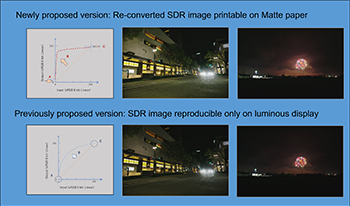
Printing display images normally proceeds well provided they comply with the SDR gamut supported by color management systems (CMS), like ICM used in Windows OS. Twilight vision, unfortunately, complicates this process, as it is quite difficult to convert images captured by UHDR systems given that their contrast ratios (CR) sometime exceeded 10^6:1 or so; SDR images have CR values of approx. 100:1. A typical example is the reproduction of lunar texture. Quite recently, we resolved this problem by employing just global tone mapping (GTM). Even with the use of GTM, emissive displays like LCD, not projection displays or printed matter, are strongly recommended to prevent image quality degradation. This study addresses the reasons why CMS fail to handle twilight vision material well and proposes enhanced GTM for printing emissive display images. The main point is the difference between the perception responses demonstrated in daytime and in twilight, even after the UHDR material is converted into SDR images. In other words, the key idea is to focus on the underutilized top and bottom margins of the reproduced SDR images. From another viewpoint, the most important result is the acquisition of super sensitivity. Our proposal enables high sensitivity even with the same sensor (increase is approx. 10 to 30 times).